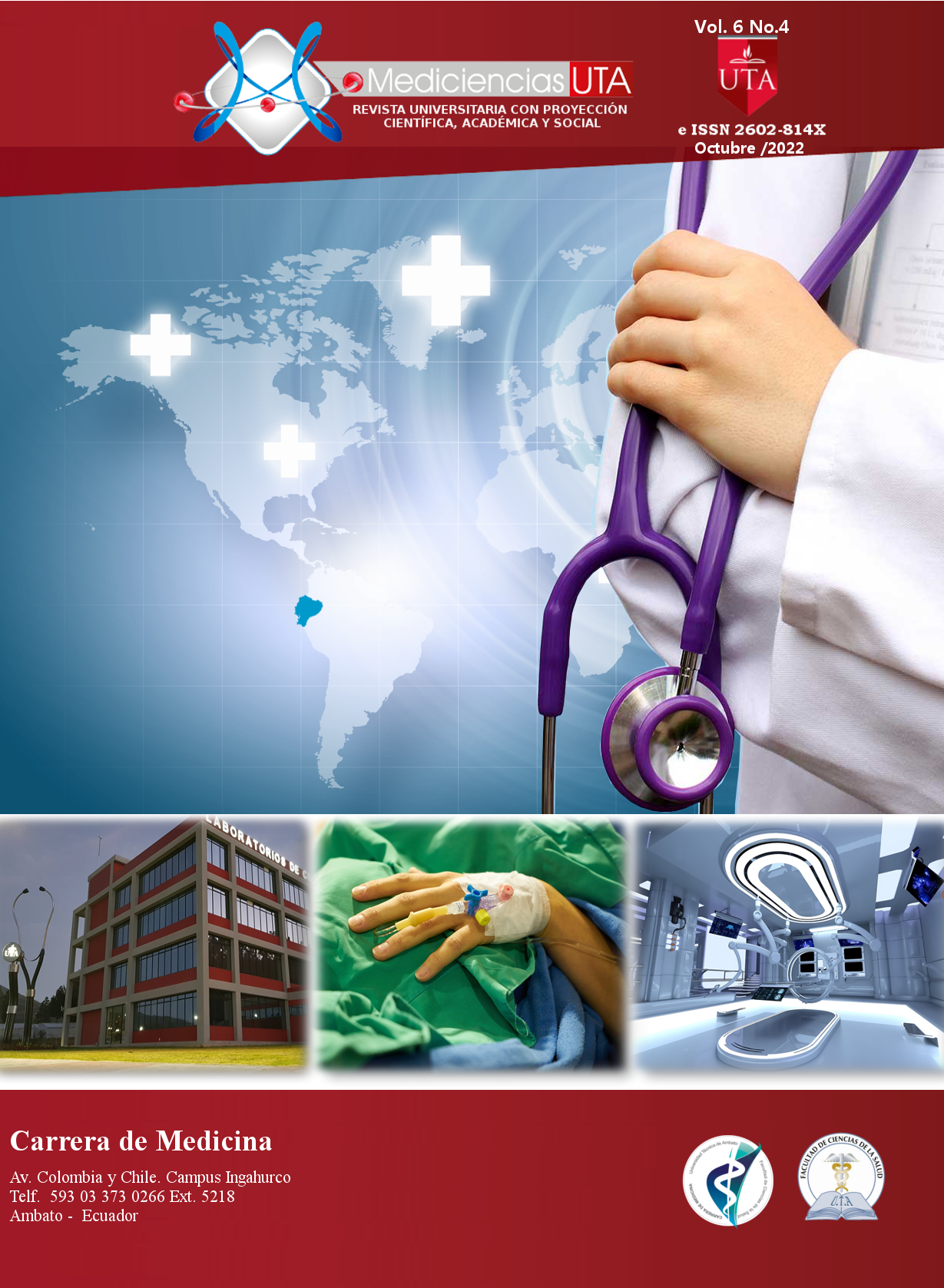Clinical case report: Esophagus-Gastro-Pexia-Cervical for Esophageal Stenosis Secondary to Ingestion of Caustics
Main Article Content
Abstract
Introduction: Esophageal stenosis caused by the ingestion of corrosive substances or by caustics, is the atrophy or narrowing of the esophagus due to the damage caused by these substances in the tissues, it is intolerable and in certain cases can cause even death. The damage can be reversible or irreversible so making a correct diagnosis will lead us to an adequate and effective treatment. It is produced principally in the upper third of the esophagus.
Objective: To describe a clinical case of esophageal stricture.
Material and methods: Retrospective descriptive study to present a clinical case.
Results: We present the case of a 22-year-old female patient who came to the emergency area of the Hospital de Especialidades Eugenio Espejo with a history of jejunostomy due to esophageal stricture caused by caustic ingestion 3 years ago.
Conclusions: Esophageal burns due to caustic ingestion are frequent, therefore the doctor must take into account that surgical treatment for esophageal stricture is indicated when dilatations are not effective, when perforation occurs or when the risk of perforation is high and when there is a need to improve the quality of life of these patients obliged to periodic dilatations and/or feeding by gastrostomy or jejunostomy, as we saw in this case presented.
There is no consensus on which surgical technique is the best, as both esophagogastroplasty and esophagocoloplasty have their advantages and disadvantages, however the surgeon should be able to say which is the best for the patient.
Downloads
Article Details

This work is licensed under a Creative Commons Attribution-NonCommercial-ShareAlike 4.0 International License.
References
Gurram RP, Kalayarasan R, Gnanasekaran S, Pottakkat B. Minimally Invasive Retrosternal Esophageal Bypass Using a Mid-Colon Esophagocoloplasty for Corrosive-Induced Esophageal Stricture. World Journal of Surgery [Internet]. 2020 Dec 1;44(12):4153–60. Available from: https://pubmed.ncbi.nlm.nih.gov/32754784/
Márquez B, Roda Diestro J, Romero Vargas S. Esofagocoloplastia en radiografía de tórax. FMC Formación Médica Continuada en Atención Primaria [Internet]. 2017 Oct 1;24(8):482–3. Available from: https://www.fmc.es/es-esofagocoloplastia-radiografia-torax-articulo-S1134207217301111
Savvi SO, Korolevska AY, Bityak SY, Novikov YA. COMPLETE THORACIC ESOPHAGUS OBLITERATION: CLINICAL CASE REPORT. Wiadomosci Lekarskie (Warsaw, Poland: 1960) [Internet]. 2021;74(1):155–60. Available from: https://pubmed.ncbi.nlm.nih.gov/33851607/
Tannuri ACA, Tannuri U. Total esophageal substitution for combined hypopharyngeal and esophageal strictures after corrosive injury in children. Journal of Pediatric Surgery [Internet]. 2017 Nov;52(11):1742–6. Available from: https://www.jpedsurg.org/article/S0022-3468(17)30104-5/fulltext
Tettey M, Edwin F, Aniteye E, Tamatey M, Entsua-Mensah K, Gyan KB, et al. Pattern of esophageal injuries and surgical management: A retrospective review. Nigerian Journal of Clinical Practice [Internet]. 2020 May 1;23(5):686–90. Available from: https://pubmed.ncbi.nlm.nih.gov/32367877/
Methasate A, Lohsiriwat V. Role of endoscopy in caustic injury of the esophagus. World Journal of Gastrointestinal Endoscopy [Internet]. 2018 Oct 16;10(10):274–82. Available from: https://www.ncbi.nlm.nih.gov/pmc/articles/PMC6198306/
Chen RJ, O’Malley RN, Salzman M. Updates on the Evaluation and Management of Caustic Exposures. Emergency Medicine Clinics of North America. 2022 May;40(2):343–64. Available from: https://pubmed.ncbi.nlm.nih.gov/35461627/
Joshi P, Yadav R, Dangi A, Kumar P, Kumar S, Gupta V, et al. Corrosive Esophageal Strictures: From Dilatation to Replacement: A Retrospective Cohort Study. Dysphagia. 2019 Sep 4;(4):558-567.Available from: https://pubmed.ncbi.nlm.nih.gov/31485830/
Tustumi F, Seguro FCB da C, Szachnowicz S, Bianchi ET, Morrell ALG, da Silva MO, et al. Surgical management of esophageal stenosis due to ingestion of corrosive substances. Journal of Surgical Research [Internet]. 2021 Aug 1 ;264:249–59. Available from: https://www.sciencedirect.com/science/article/abs/pii/S0022480421001335
Ain QU, Jamil M, Safian HA, Akhter TS, Batool S, Arshad M, et al. Assessing the Degree of Acute Esophageal Injury Secondary to Corrosive Intake: Insights From a Public Sector Hospitals of a Developing Country. Cureus. 2020 Oct 8; 12(10): e10858. Available from: https://www.ncbi.nlm.nih.gov/pmc/articles/PMC7652017/
Mederos Curbelo ON, Santell Odio F, Barrera Ortega JC, Mederos Curbelo ON, Santell Odio F, Barrera Ortega JC. Estenosis tardía con retracción del colon al mediastino en una esofagocoloplastia retroesternal. Revista Cubana de Cirugía [Internet]. 2021 Mar 1;60(1). Available from: http://scielo.sld.cu/scielo.php?script=sci_arttext&pid=S0034-74932021000100010
Spitz L, Coran A. Gastric Transposition for Oesophageal Replacement. Springer Surgery Atlas Series. 2019;67–71.Available from:https://link.springer.com/chapter/10.1007/978-3-662-56282-6_10#citeas
Ali Harlak, Taner Yigit, Kagan Coskun, Tahir Ozer, Oner Mentes Surgical treatment of caustic esophageal strictures in adults. International Journal of Surgery [Internet]. 2013 Mar 1;11(2):164–8. Available from: https://www.sciencedirect.com/science/article/pii/S1743919112008576
BRAGHETTO I, FIGUEROA M, SANHUEZA B, LANZARINI E, SEPULVEDA S, ERAZO C. PHARYNGO-ILEO-COLO-ANASTOMOSIS WITH MICRO-VASCULAR BLOOD SUPPLY AUGMENTATION FOR ESOPHAGO-GASTRIC REPLACEMENT DUE TO ESOPHAGO-GASTRIC NECROSIS AFTER CAUSTIC INGESTION. ABCD Arquivos Brasileiros de Cirurgia Digestiva (São Paulo) [Internet]. 2018 Jul 2 ;31(2). Available from: https://www.ncbi.nlm.nih.gov/pmc/articles/PMC6044192/
Bakshi A, Sugarbaker DJ, Burt BM. Alternative conduits for esophageal replacement. Annals of Cardiothoracic Surgery [Internet]. 2017 Mar 1 [cited 2022 Sep 17];6(2):137–43. Available from: https://www.ncbi.nlm.nih.gov/pmc/articles/PMC5387143/
Handaya Y, Sunardi M. Ileocolonic Transposition Esophagogastric Bypass as an Antireflux Treatment for Corrosive Esophageal Injury. Annals of Coloproctology [Internet]. 2017 Aug 31;33(4):150–5. Available from: https://www.ncbi.nlm.nih.gov/pmc/articles/PMC5603345/
Irino T, Tsekrekos A, Coppola A, Scandavini CM, Shetye A, Lundell L, et al. Long-term functional outcomes after replacement of the esophagus with gastric, colonic, or jejunal conduits: a systematic literature review. Diseases of the Esophagus: Official Journal of the International Society for Diseases of the Esophagus [Internet]. 2017 Dec 1 ;30(12):1–11. Available from: https://pubmed.ncbi.nlm.nih.gov/28881882/
Lusong MAAD, Timbol ABG, Tuazon DJS. Management of esophageal caustic injury. World Journal of Gastrointestinal Pharmacology and Therapeutics [Internet]. 2017 ;8(2):90. Available from: https://www.ncbi.nlm.nih.gov/pmc/articles/PMC5421115/
Rammohan A. Corrosive Injury of the Upper Gastrointestinal Tract: A Review. Archives of Clinical Gastroenterology. 2016 Jul 27;056–62. Available from: https://www.peertechzpublications.com/Clinical-Gastroenterology/ACG-2-122.php
Kluger Y, Ishay OB, Sartelli M, Katz A, Ansaloni L, Gomez CA, et al. Caustic ingestion management: world society of emergency surgery preliminary survey of expert opinion. World Journal of Emergency Surgery. 2015 Oct 16;10(1). Available from: https://wjes.biomedcentral.com/articles/10.1186/s13017-015-0043-4



